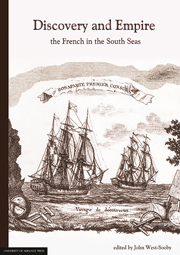Book contents
- Frontmatter
- Contents
- List of Figures
- List of Contributors
- Acknowledgements
- Introduction
- Note on the Second Frank Horner Lecture
- 1 The Globe Encompassed: France and Pacific Convergences in the Age of the Enlightenment
- 2 The Abbé Paulmier's Mémoires and Early French Voyages in Search of Terra Australis
- 3 The Acquisitive Eye? French Observations in the Pacific from Bougainville to Baudin
- 4 Discovering the Savage Senses: French and British Explorers' Encounters with Aboriginal People
- 5 A Case of Peripheral Vision: Early Spanish and French Perceptions of the British Colony at Port Jackson
- 6 New Creatures Made Known: Some Animal Histories of the Baudin Expedition
- 7 “Primitive race”, “pure race”, “brown race”, “every race”: Louis Freycinet's Understanding of Human Difference in Oceania
- 8 Imperial Eyes on the Pacific Prize: French Visions of a Perfect Penal Colony in the South Seas
6 - New Creatures Made Known: Some Animal Histories of the Baudin Expedition
Published online by Cambridge University Press: 05 April 2014
- Frontmatter
- Contents
- List of Figures
- List of Contributors
- Acknowledgements
- Introduction
- Note on the Second Frank Horner Lecture
- 1 The Globe Encompassed: France and Pacific Convergences in the Age of the Enlightenment
- 2 The Abbé Paulmier's Mémoires and Early French Voyages in Search of Terra Australis
- 3 The Acquisitive Eye? French Observations in the Pacific from Bougainville to Baudin
- 4 Discovering the Savage Senses: French and British Explorers' Encounters with Aboriginal People
- 5 A Case of Peripheral Vision: Early Spanish and French Perceptions of the British Colony at Port Jackson
- 6 New Creatures Made Known: Some Animal Histories of the Baudin Expedition
- 7 “Primitive race”, “pure race”, “brown race”, “every race”: Louis Freycinet's Understanding of Human Difference in Oceania
- 8 Imperial Eyes on the Pacific Prize: French Visions of a Perfect Penal Colony in the South Seas
Summary
“Captain, if we had not been kept so long picking up shells and catching butterflies at Van Diemen's Land, you would not have discovered the South Coast before us.”
—
Henri Freycinet to Matthew Flinders, Port Jackson, 1802One of the most precious items in the collection of the Tasmanian Museum and Art Gallery is a delicate, double-shafted feather. Placed on a cushion, overlaid with plastic and locked in a glass case, it is considered too valuable to be put on public display. This is the only confirmed feather in Australia of Dromaius ater, the dwarf emu of King Island, Bass Strait, extinct in the wild since 1805.
The feather was a gift from the Muséum national d'Histoire naturelle in Paris. The original owner of the feather was captured during Nicolas Baudin's 1800-1804 voyage of discovery to the southern lands. The owner of the original owner of the feather was at one time Madame Bonaparte, soon to be Empress Josephine. Baudin expedition naturalist François Péron documented the only detailed description of the emu's life history, and Charles-Alexandre Lesueur's illustrations are the only visual record of a living individual. This bird was at one time so valued that he and another dwarf emu appear in the medallion on the frontispiece of the Atlas accompanying the only State-sanctioned account of the expedition, Péron's Voyage de découvertes aux Terres Australes (Figure 6.1).
- Type
- Chapter
- Information
- Discovery and EmpireThe French in the South Seas, pp. 171 - 214Publisher: The University of Adelaide PressPrint publication year: 2013



